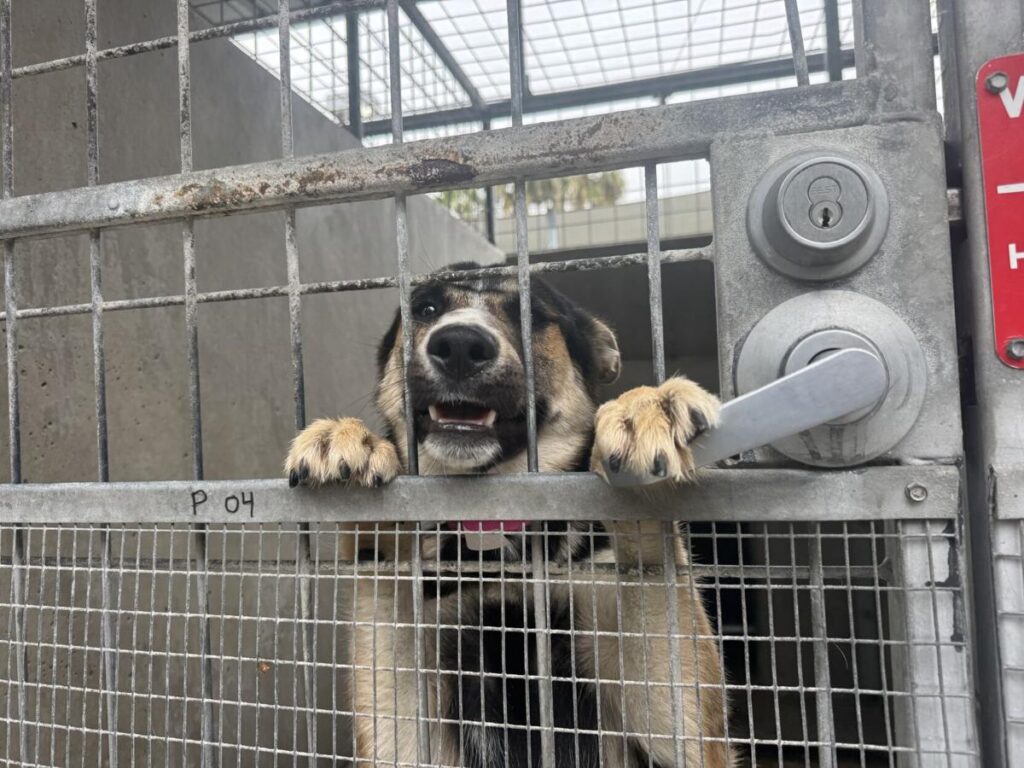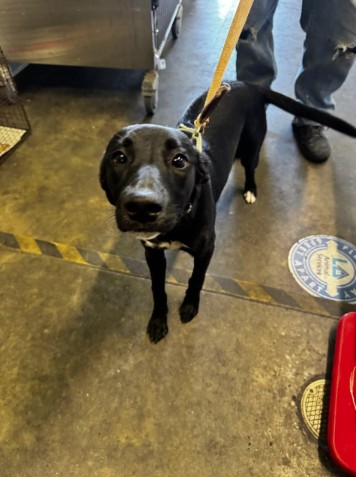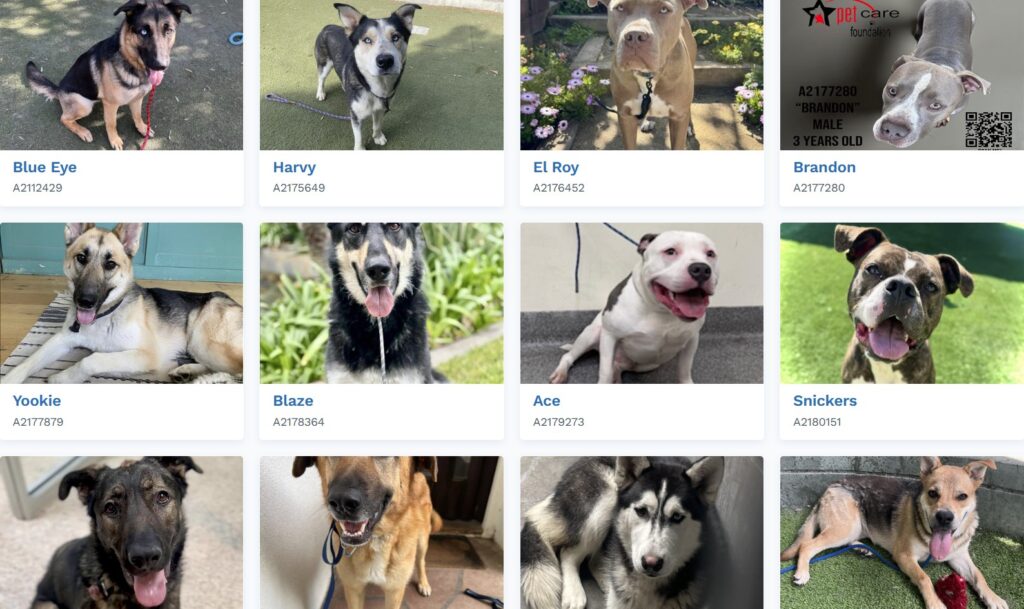(Editor’s note: This Article first appeared in the Westside Current on August 7, 2025, and is reprinted with permission.)

A dog eager for attention at the Harbor Animal Shelter in San Pedro—one of many shelters struggling with overcrowding. Photo: JAMIE PAIGE
City Council’s silent vote strips funding from key spay and neuter providers—putting overcrowded shelters and at-risk animals in deeper crisis.
At first glance, it looked like progress. On August 1, the Los Angeles City Council unanimously approved a motion to raise reimbursement rates for the city’s free spay and neuter vouchers. The 13-0 vote —quietly passed on the consent calendar without discussion—was led by Councilmember Eunisses Hernandez and pitched as a step toward reducing pet overpopulation.
But for the city’s overcrowded animal shelters and the clinics that support them, the decision may have set the system back years.
The Council’s motion raised rates only for pet owners using free public vouchers—omitting critical programs used by rescue groups, high-volume nonprofit clinics, and shelter-based providers that together perform tens of thousands of surgeries annually.
The last-minute change effectively gutted a broader proposal previously endorsed by the Budget and Finance Committee, which would have covered all voucher categories, including shelter animals, trap-neuter-return efforts, and rabbits.
“It’s like patching one tire on a car with four flats,” said Zoey Knittel, executive director of the Community Animal Medicine Project (CAMP), which operates stationery and mobile spay/neuter clinics throughout Los Angeles. “They gave the appearance of solving the problem, but in reality, they undercut the very system that keeps animals alive.”
Now, organizations like CAMP—and funders like the Michelson Center for Public Policy, which supports dozens of mobile and stationary clinics across underserved communities—warn that the vote will have costly and immediate consequences. Shelters already over capacity will likely see increased lengths of stay, more intakes, and ultimately, more euthanasia.
The city’s decision may have been swift, but its fallout will be anything but.
A System Beyond Capacity
The Los Angeles shelter system is drowning. In 2023, shelters housed nearly twice the number of animals they were built to hold.
In the South Los Angeles shelter, 2-year-old Sara, who suffered from “hind-end weakness” with no diagnosed medical cause, was euthanized when no one came to adopt her. So was Buttercup, a healthy and affectionate dog who had spent eight months in the shelter system. She was walked by volunteers, wore a bow in her adoption photo, learned commands and was called “amazing.”
But she died anyway.
In one week alone in 2023, 20 dogs were put down. Volunteers wept. Advocates blamed inaction. And behind every story, the same math surfaced: the shelter system is full, the veterinary pipeline is broken, and the city’s spay and neuter program hadn’t kept pace.
That pattern has continued into 2025.
While the city has not released full euthanasia data for the current year, reports from late 2024 showed a dramatic rise in the number of animals killed in shelters. Between January and September 2024, 15,083 dogs were taken in and 1,224 euthanized—a 72% increase in euthanasia over the same period in 2023.
And in May 2025, LA Animal Services itself issued an urgent call for help.
“More than 900 dogs are in our custody and the numbers continue to climb,” the department posted on Instagram on May 1. “Without immediate help, healthy, adoptable pets are at risk of euthanasia simply due to lack of space.”
The Chesterfield Square/South LA shelter alone was housing nearly 250 dogs and puppies. The agency pleaded for adopters, fosters, and donors, and cut adoption fees every weekend in May.
Meanwhile, nonprofit groups like South LA Animal Shelter Volunteers continued to post daily images of dogs in urgent need, many with euthanasia deadlines listed in hours.
The Missed Opportunity
Back in January, the City Administrative Officer proposed a phased three-year plan to raise spay/neuter voucher rates gradually for all voucher types: dogs in Year One, cats in Year Two, and rabbits in Year Three. It was designed to be cost-effective, predictable, and scalable. The plan was widely supported by animal welfare providers, who said it would finally bring fairness and sustainability to a critical system.
The plan would have increased the value of sterilization vouchers incrementally and across all channels—including public, nonprofit, and rescue groups—ensuring providers could plan budgets and increase capacity without shutting down programs.
Instead, the Council approved only Year One of a different plan—Alternative 1—at a cost of $9.24 million. This increased reimbursements for only public-facing free certificates.
It left out the high-volume workhorse programs used by rescues and mobile clinics, which have been operating for years on decade-old rates.
The Michelson Center for Public Policy — a nonprofit organization that advances legislative change through strategic collaboration with policymakers, advocacy organizations, and civic leaders — said it was caught off guard by the motion and the vote.
“Excluding on-site providers for shelter animals from the updated voucher is likely to create service bottlenecks at Los Angeles Animal Services clinics,” said Jana Brennan, who oversees spay/neuter initiatives at the Michelson Center for Public Policy. “We’re going to see longer shelter stays, delayed adoptions, and eventually, higher euthanasia rates.
Brennan said Michelson’s efforts are focused on building spay and neuter capacity in areas with the highest need. So far in 2025, the organization has funded sterilization for over 2,100 animals across Greater Los Angeles through nearly 30 mobile clinic events—many of them in low-income or underserved communities.
“We know the population continues to grow, but what’s critical is understanding how the lack of spay and neuter access trickles down into the entire shelter ecosystem,” said Brennan. “If providers like CAMP can’t access increased voucher funding, we’ll inevitably see more animals entering shelters, longer lengths of stay, and ultimately higher euthanasia rates.”
Brenan highlighted that a recent national study showed that unaltered animals stayed in shelters significantly longer—up to 11 days more for cats. In L.A., where the average cost per animal is about $40 a day, “The financial and emotional toll is staggering.”
At CAMP’s East Valley (EV) Clinic alone, the projected shortfall is $362,500 per year. For dogs, the disparity is even greater. The city currently reimburses $125 per dog, while the proposed rate would have provided $195. The $70 difference, multiplied by approximately 2,500 dog surgeries per year, translates to an additional $175,000 in underfunding. These numbers reflect just one of CAMP’s clinic sites.
The financial impact expands further when factoring in CAMP’s other fixed clinics, including those located in Harbor, Jefferson Park, and Northeast Valley. Combined, these clinics are expected to lose another $350,000 annually due to the City Council’s limited voucher expansion—bringing the organization’s total projected loss to more than $700,000 a year.
“We’re subsidizing basic public health services for the city. The financial burden is now so extreme, it threatens to collapse the infrastructure keeping thousands of animals alive,” Knittel said. “It’s fiscally irresponsible not to properly fund this system. At the South L.A. shelter alone, the city is spending $12,000 per day to house animals. That’s over $4 million a year—money that could be used to prevent animals from entering the shelter in the first place.”
She noted that only 29 veterinarians still accept city Free Vouchers, down from 85, as many can no longer afford to operate under obsolete reimbursement rates.
“For too long, the burden of this broken system has fallen on donors and nonprofits. It’s time for the city to fully fund its own public health programs—and stop outsourcing survival to charity,” Knittel added.
Both CAMP and the Michelson Center for Public Policy say they’ve maintained a collaborative relationship with the City of Los Angeles in efforts to address the region’s deepening pet overpopulation crisis. Since late last year, representatives from both organizations have worked closely with city officials and council offices to help shape spay and neuter policy and funding recommendations. They were particularly engaged in responding to early proposals from the City Administrative Officer (CAO), which suggested a phased voucher increase over three years that excluded key provider types.
“We understood the city was facing budget constraints,” said Brennan, “but we pushed for a more equitable plan that covered all voucher types—free, discount, shelter-based, and those supporting TNR efforts through the Citywide Cat Program.”
By June, after months of discussions and testimony, the Budget and Finance Committee, led by Councilmember Bob Blumenfield and others, appeared to land on a balanced solution. That proposal—referred to as “Alternative 1”—would have increased voucher reimbursement across the board, including for shelter animals, rabbits, and community cats. It had broad support among animal welfare advocates.
But when the item quietly returned to Council in early August, the motion had reverted to an earlier version from the Arts, Parks, Libraries and Community Enrichment Committee. The adopted motion raised rates only for owned pets, leaving out high-volume providers like CAMP and excluding rabbits and the Citywide Cat Program entirely.
“It was a surprise,” Brennan said. “We thought we had reached a place of consensus that reflected the real on-the-ground needs. The last-minute shift not only excluded essential providers, but it risks creating bottlenecks in the shelter system that we’ve worked for years to alleviate.”
Brennan also said the vote reversed momentum that had been building since February 2024, when Michelson Found Animals awarded a historic $1 million grant to CAMP to expand services. “This wasn’t just about funding—it was about fixing a broken pipeline with a community-based solution,” Brennan said. “Now that pipeline is going to start backing up again.”
In a statement following the vote, Dr. Gary K. Michelson, founder and co-chair of the Michelson Center for Public Policy, said the decision would deepen the city’s ongoing shelter crisis.
“The overcrowding of our shelters is a direct consequence of the city’s failure to provide basic services to families and their pets. Without widely accessible and affordable spay & neuter, unwanted litters flood our shelters, and stay there, because they cannot be adopted until they are sterilized. By excluding proven spay and neuter providers from the voucher program, the City Council has created a bottleneck that will deepen the crisis and leave animals waiting in overcrowded kennels. Los Angeles taxpayers and the animals sentenced to die in our shelters deserve better. We shouldn’t be paying for a pound of cure because we neglected to provide the ounce of prevention.”
And when it comes to the city’s bottom line, both Brennan and Knittel say the math is simple: prevention costs less than crisis care.
“When you’re spending $70 to $300 per animal for spay and neuter services—and comparing that to $40 per day to house an animal in a shelter for weeks—you don’t have to be a budget analyst to see which approach saves money,” Brennan said. “That $40 per day adds up fast, especially when shelters are over 125% capacity, as we’ve seen in recent weeks.”
A City with No Plan B
“It gives me chills just thinking about it,” said Jacqui Piñol, founder of The Canine Condition Foundation, which provides free and low-cost sterilization services to underserved communities. “They gave the appearance of solving the problem, but in reality, they undercut the very system that keeps animals alive.”
“We shouldn’t be fighting with the City Council. We should be working with them.”
“Less than a month after unanimously approving spay/neuter support, City Council quietly gutted it behind closed doors- abandoning, once again, the only proven solution to shelter overpopulation,” said Shira Astrof, founder of The Animal Rescue Mission. “Eunisses voted with the majority, confirming what many of us suspected: her so-called advocacy is purely performative, while the rest of Council likely had no idea what they were voting on, blindly following Mayor Bass’s office.
“Meanwhile, private spay/neuter organizations like the newly formed CaraVita – which I’m proud to be part of – are funding basic public health services the city refuses to support.
“These actions are fiscally reckless, morally inexcusable, and proof we need entirely new leadership.”
Brennan said she believes the Council didn’t fully understand what they were voting on. “Many councilmembers didn’t seem to realize who was being excluded. It’s setting the entire ecosystem up to fail.”
The Westside Current reached out to Councilmembers Eunisses Hernandez, Tim McOsker, Katy Yaroslavsky, and Bob Blumenfield — all of whom serve on the City Council’s Budget and Finance Committee — to ask about the August 1 vote. Both McOsker and Blumenfield were absent for the vote.
Only Blumenfield responded, telling the Current: “I have been a big advocate for spay and neuter programs, having shepherded state legislation in the Assembly and having championed maximum funding as a Councilmember. While the broader voucher expansion was not approved, I am actively working with Animal Services to secure funding to include rabbits in the program. It’s the right thing to do, for humane and financial reasons.”
“Our shelters are killing healthy, adoptable dogs because we can’t move them fast enough,” Piñol said. “This vote just made that worse.
“I can’t explain why one of the richest cities in the world can’t figure this out,” she said.
To see adoptable animals in L.A. City Shelters click here.




